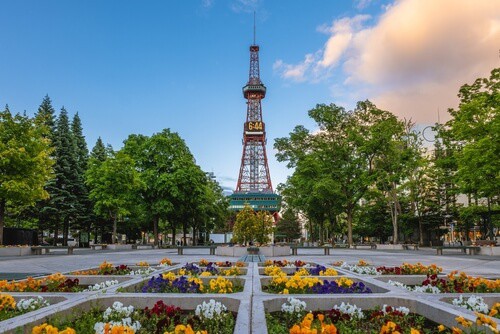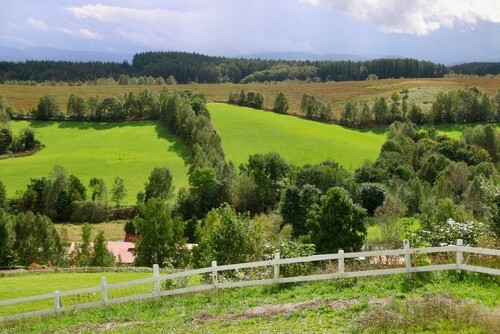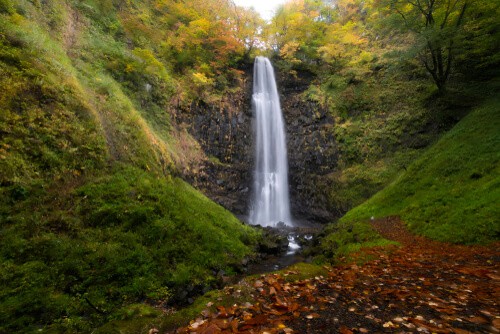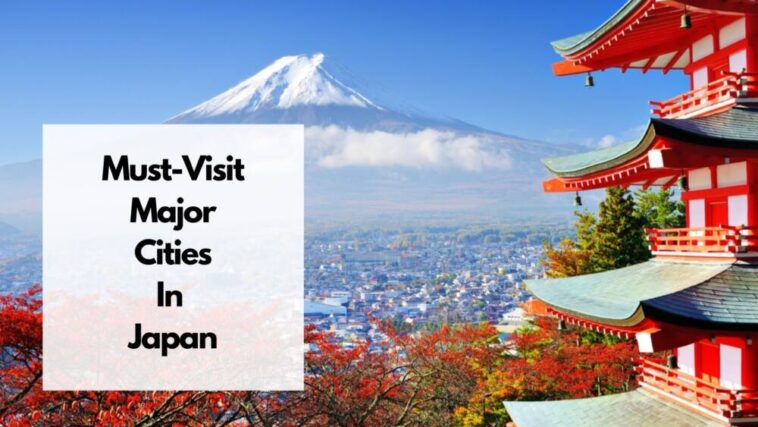Here are cities in Japan that start with S.
Step into a world where ancient temples whisper tales of samurai, neon signs paint the night sky, and bullet trains whisk you between bustling metropolises and tranquil fishing villages.
This is the captivating landscape of Japan’s “S” cities, waiting to surprise and delight you.
Join us as we embark on a whirlwind tour, from Hokkaido’s snowy slopes to Kyushu’s sun-kissed beaches, discovering the unique charm of each urban gem along the way.
Page Contents
Cities In Japan That Start With S
Sapporo

Sapporo, the capital of Hokkaido, seamlessly blends modern urban life with the breathtaking beauty of its surrounding natural landscapes.
Famous for its annual Snow Festival, Sapporo offers a vibrant cultural scene, diverse culinary experiences, and numerous parks.

The city’s well-planned infrastructure includes the iconic Sapporo TV Tower and Odori Park, providing residents and visitors with a dynamic mix of leisure and recreation.
Shibetsu
Nestled amid scenic landscapes, Shibetsu stands as a serene city that encapsulates the essence of rural Japan. Surrounded by nature, it offers a tranquil lifestyle, with opportunities for outdoor activities.

Shibetsu’s charm lies in its simplicity, making it an ideal escape for those seeking a peaceful environment away from the hustle and bustle of more urbanized areas.
Shizunai
Shizunai is a city where tradition and modernity coexist harmoniously. Set against a backdrop of lush greenery, the city preserves its cultural heritage while embracing contemporary living.

Residents can enjoy a blend of traditional festivals, serene temples, and modern amenities, creating a well-rounded and culturally rich community.
Shinhidaka
As a charming town with a rich agricultural heritage, Shinhidaka captivates visitors with its sprawling farmlands and idyllic countryside.
Agriculture plays a pivotal role in the local economy, and the town’s residents take pride in preserving and celebrating their rural traditions. Shinhidaka offers a peaceful escape where one can appreciate the beauty of nature and the simplicity of life.
Suttsu
Suttsu, a coastal town, paints a picturesque scene with its stunning views of the sea and fishing communities. The town is known for its maritime charm and the close-knit relationship between its residents and the ocean.
Fishing is a significant part of Suttsu’s identity, contributing to both its economy and cultural heritage.
Sakata
Steeped in history, Sakata is a city that invites exploration of its well-preserved samurai district and Edo-period warehouses.

The city’s architectural heritage tells the story of its past, while vibrant cultural festivals and events showcase a community proud of its traditions. Sakata’s unique blend of history and local artistry makes it a captivating destination for both residents and visitors alike.
Sendai
As a government-designated city, Sendai stands as a dynamic urban center on Honshu island. Boasting a rich history and modern infrastructure, Sendai is known for its vibrant shopping districts, cultural attractions, and green spaces.
The city’s iconic Zuihoden Mausoleum and Aoba Castle are testament to its historical significance, while festivals like Tanabata Matsuri add a colorful flair to its cultural scene.
Shiogama
Shiogama, a coastal city, harmonizes tradition with maritime charm. Known for its longstanding fishing industry, the city offers fresh seafood markets and historic shrines. Matsushima Bay, famous for its scenic islands, is a short distance away.
Shiogama provides a unique blend of cultural heritage and natural beauty, making it a captivating destination.
Shirakawa
Shirakawa is a city known for its well-preserved thatched-roof houses, designated as a UNESCO World Heritage site.
The historic village of Ogimachi, with its traditional Gassho-style architecture, showcases the region’s rural charm. Shirakawa provides a glimpse into Japan’s agricultural heritage and offers a serene atmosphere surrounded by stunning landscapes.
Soma
Soma, an agricultural city, is characterized by vast farmlands and a strong connection to traditional farming practices.
The city’s rural landscapes provide a peaceful retreat, and its festivals, such as the Soma Nomaoi, celebrate centuries-old equestrian traditions. Soma’s cultural richness is intertwined with its natural beauty.
Sukagawa
Sukagawa is a city that strikes a balance between urban development and natural beauty. Its scenic parks and historical sites, like the ruins of Matsudaira Castle, create a backdrop for a diverse range of activities.
Sukagawa’s commitment to preserving its cultural heritage makes it an engaging destination for those seeking a mix of history and modernity
Saitama
Saitama, a government-designated city, stands as a bustling urban hub neighboring Tokyo. The city combines modern amenities with cultural attractions, such as the Omiya Bonsai Village and the historic Kawagoe district.
Saitama’s diverse neighborhoods offer a rich tapestry of urban living, and its proximity to Tokyo adds to its appeal as a vibrant metropolitan area.
Sano
Sano, a city with a rich historical background, exudes a blend of old-world charm and modern convenience. Notable for its historic temples and well-preserved merchant houses, the city provides a glimpse into Japan’s past. Sano’s local festivals, such as the Sano Taun no Yuube, add a lively cultural touch to the community.
Sasagawa
Nestled in the countryside, Sasagawa offers a serene escape surrounded by natural beauty. The town’s picturesque landscapes, including rolling hills and tranquil rivers, create an idyllic setting.
Sasagawa’s residents appreciate a slower pace of life, emphasizing the town’s connection to nature and its traditional Japanese atmosphere.
Sawara
Sawara, a city frozen in time, features well-preserved Edo-period architecture and scenic canals. The town’s historic charm is evident in its traditional merchant houses and vibrant festivals, such as the Sawara Grand Festival.
Sawara’s canal-side streets provide a nostalgic journey through Japan’s past, making it a popular destination for history enthusiasts.
Shibukawa
Surrounded by hot springs and lush landscapes, Shibukawa is a haven for relaxation and outdoor enthusiasts. The city boasts renowned hot spring resorts like Ikaho and Shima, offering therapeutic experiences.
Shibukawa’s historical sites, such as Mizusawa Kannon Temple, complement its natural beauty, creating a well-rounded destination for visitors.
Shimodate
Shimodate is a city where history unfolds against a backdrop of scenic beauty. Historical landmarks like the Shimodate Castle and vibrant cherry blossoms in spring make it a visually appealing destination.
The city’s blend of traditional culture and modern amenities creates an atmosphere where past and present coexist harmoniously.
Shimonita
Shimonita, a tranquil village surrounded by mountains, offers a peaceful retreat from urban life. The village’s natural beauty and simplicity create an environment where residents can appreciate the changing seasons.
Shimonita’s rural landscapes and traditional architecture contribute to a sense of timelessness, providing a serene living experience.
Shiraoka
Shiraoka is a city that seamlessly blends modern amenities with traditional charm. The city’s historical sites, such as the Shiraoka Hachiman Shrine, coexist with contemporary developments, creating a unique cultural atmosphere.
Shiraoka’s commitment to preserving its heritage adds character to its urban landscape.
Shōbu
Known for its agricultural heritage, Shōbu is a city that offers a tranquil escape from the bustling urban life. Fields and farmlands surround the city, contributing to its rural charm.
Shōbu’s connection to nature and farming traditions provides a serene backdrop for residents seeking a quieter, more laid-back lifestyle.
Sōka
Sōka is a city that strikes a harmonious balance between urban development and greenery. Parks and recreational spaces, such as the Sōka Park and Toda Shinmeigu Shrine, enhance the city’s livability.
Sōka’s cultural events and local festivals add vibrancy to the community, making it an attractive place to live.
Sugito
Sugito is a town that embraces its rural roots, offering a peaceful retreat amid nature. The town’s agricultural landscapes and traditional Japanese architecture contribute to its serene atmosphere.
Sugito’s commitment to preserving its cultural heritage makes it an ideal destination for those seeking a connection to traditional Japan.
Sabae
Famed for its eyewear industry, Sabae is a city where craftsmanship and innovation converge. The city’s dedication to producing high-quality eyewear has earned it a global reputation.
Sabae’s unique identity as an eyewear hub, coupled with its cultural events, makes it a distinctive and thriving community.
Sakado
Sakado is a city with a mix of history and modernity, offering a glimpse into Japan’s past. Historical sites like the Oiwa Shrine and the Sakado Castle Ruins coexist with contemporary amenities.
Sakado’s blend of traditional and modern elements creates an enriching environment for residents and visitors alike.
Sakaiminato
Sakaiminato is a city with a quirky charm, celebrated for its eccentric fish-themed street and as the birthplace of a famous manga artist.
The city’s vibrant atmosphere, seafood markets, and unique attractions make it a delightful destination for both locals and tourists.
San’yō-Onoda
San’yō-Onoda is a city that seamlessly blends industry with nature. Nestled between mountains and the sea, the city offers a diverse range of amenities and scenic surroundings. San’yō-Onoda’s commitment to environmental harmony adds to its appeal as a well-rounded community.
Shimonoseki
Shimonoseki is a bustling port city known for its rich seafood, historical significance, and vibrant market.
The city’s iconic Kanmon Bridge connects Honshu and Kyushu, symbolizing the unity of the two regions. Shimonoseki’s maritime heritage and culinary delights attract visitors from near and far.
Suō-Ōshima
Suō-Ōshima is an island city with a rich maritime history, offering coastal beauty and cultural attractions.
The island’s historic shrines, traditional festivals, and scenic landscapes make it a unique destination. Suō-Ōshima provides a tranquil island lifestyle surrounded by the Seto Inland Sea.
Saijō
Saijō is a city with a strong connection to sake production, featuring numerous breweries and cultural events centered around the traditional Japanese drink. The city’s sake-related activities, along with historical sites like the Saijō Inari Shrine, create a vibrant cultural atmosphere.
Sakawa
Sakawa is a city that combines historical charm with modern convenience, providing a pleasant living environment.
The city’s cultural sites, parks, and local events contribute to its community spirit. Sakawa’s commitment to preserving its heritage ensures a blend of tradition and contemporary living.
Sukumo
Sukumo is a city surrounded by nature, offering a peaceful retreat with scenic landscapes and cultural attractions.
The city’s proximity to the Pacific Ocean enhances its coastal charm, while historical sites like the Sukumo Castle Ruins provide a glimpse into its past. Sukumo’s tranquil ambiance and connection to nature make it an ideal destination for those seeking serenity.
Saga
Saga is a city with a rich cultural heritage, featuring historical landmarks and a connection to Japan’s feudal past. The city’s iconic Saga Castle and Yutoku Inari Shrine contribute to its historical significance.
Saga’s commitment to preserving its traditions, combined with modern developments, creates a dynamic and culturally rich environment.
Saiki
Saiki is a coastal city that embraces its maritime heritage, offering a mix of fishing culture, historical sites, and scenic beauty.
The city’s coastal landscapes and seafood markets reflect its deep connection to the sea. Saiki’s festivals and events celebrate both its maritime traditions and cultural diversity.
Saito
Saito is a city with a blend of urban development and natural landscapes, providing a diverse range of lifestyle options.
The city’s parks, historical sites like the Saito Castle Ruins, and cultural events contribute to its vibrancy. Saito’s strategic location between mountains and coast enhances its appeal as a well-rounded community.
Saikai
Saikai is a city known for its coastal beauty and maritime activities, providing a tranquil living environment.
The city’s islands, such as Hirado and Ikitsuki, offer stunning landscapes and historic sites. Saikai’s connection to the sea, coupled with its cultural festivals, makes it a captivating destination.
Sasebo
Sasebo is a port city with a unique blend of Japanese and Western influences, offering historical sites and a diverse culinary scene.
The city’s Kujukushima Islands, Glover Garden, and Sasebo Peace Park showcase its cultural diversity. Sasebo’s naval history and international influences contribute to its distinctive character.
Satsumasendai
Satsumasendai holds historical significance with ties to the Satsuma Rebellion. The city features traditional architecture, including Kagoshima Castle and the Shimadzu Residence, reflecting its samurai heritage.
Satsumasendai’s vibrant festivals and lush landscapes contribute to a dynamic blend of history and natural beauty.
Shimabara
Shimabara is a city known for its historical sites, including Shimabara Castle and the Shimabara Peninsula.
The city’s hot springs and scenic landscapes provide a relaxing retreat. Shimabara’s rich cultural heritage, influenced by its samurai past, offers visitors a glimpse into feudal Japan.
Shimonoseki
As a bustling port city, Shimonoseki is renowned for its seafood, historical significance, and vibrant Karato Market.
The city’s role in Japanese history is highlighted by sites like Akama Shrine and the Kanmon Straits. Shimonoseki’s blend of maritime charm and cultural attractions makes it a compelling destination.
Shinagawa
Shinagawa serves as a major transportation hub in Tokyo, boasting a mix of modernity and business districts.
The city’s waterfront areas, such as Odaiba and Tokyo Bay, offer recreational spaces. Shinagawa’s historical sites, including shrines and temples, contribute to its dynamic urban landscape.
Shingu
Shingu is a city with a rich spiritual heritage, featuring the Kumano Hayatama Taisha Shrine and the Nachi Falls.
The city’s connection to the Kumano Kodo pilgrimage route adds to its cultural significance. Shingu’s picturesque landscapes and traditional festivals make it a spiritually enriching destination.
Sōma
Sōma is a city with a strong connection to agriculture, offering rural landscapes and traditional farming practices. The city’s annual Sōma Nomaoi festival showcases equestrian traditions. Sōma’s commitment to preserving its agricultural heritage adds to its rural charm.
Sukumo
Sukumo is a city surrounded by nature, offering a peaceful retreat with scenic landscapes and cultural attractions. The city’s proximity to the Pacific Ocean enhances its coastal charm, while historical sites like the Sukumo Castle Ruins provide a glimpse into its past.
Sukumo’s tranquil ambiance and connection to nature make it an ideal destination for those seeking serenity.
Shimoji
Shimoji is a city with a focus on maritime activities, offering coastal beauty and a relaxed island lifestyle. The city’s Shimoji-jima Island features pristine beaches and coral reefs. Shimoji’s connection to Okinawan culture and its role as a transportation hub contribute to its island allure.
Conclusion
From snowy Sapporo to sun-drenched Sasebo, Japan’s “S” cities have painted a vibrant tapestry of ancient shrines, neon skylines, and bullet-train journeys.
Each one whispered unique stories, leaving us breathless with their intricate blend of tradition and innovation.
Though we’ve only scratched the surface, one thing is clear: Japan’s “S” cities are an irresistible invitation to lose yourself, discover hidden gems, and be forever woven into their magic.
Also Read:





